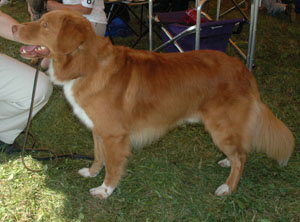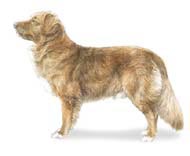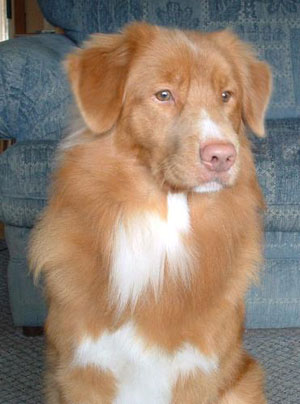Nova Scotia Duck Tolling Retriever Breed Standard
General Appearance
The Nova Scotia Duck Tolling Retriever (Toller) was developed in the early 19th century to toll, lure, and retrieve waterfowl. The playful action of the Toller retrieving a stick or ball along the shoreline arouses the curiosity of the ducks offshore. They are lured within gunshot range, and the dog is sent out to retrieve the dead or wounded birds.
 This medium sized, powerful, compact, balanced dog is the smallest of the retrievers. The Toller's attitude and bearing suggest strength with a high degree of agility. He is alert, determined, and quick, with a keen desire to work and please. This medium sized, powerful, compact, balanced dog is the smallest of the retrievers. The Toller's attitude and bearing suggest strength with a high degree of agility. He is alert, determined, and quick, with a keen desire to work and please.
Many Tollers have a slightly sad or worried expression when they are not working. The moment the slightest indication is given that retrieving is required, they set themselves for springy action with an expression of intense concentration and excitement. The heavily feathered tail is held high in constant motion while working.
The Nova Scotia Duck Tolling Retriever Club (USA) feels strongly that all Tollers should have these innate abilities, and encourages all Tollers to prove them by passing an approved Nova Scotia Duck Tolling Retriever Club (USA) field test.
Size, Proportion and Substance
Size: Height at the withers - males, 18-21 inches. The ideal is 19 inches. Females, 17-20 inches. The ideal is 18 inches. Bone: is medium. Weight is in proportion to height and bone of the dog. The dog's length should be slightly longer than height, in a ratio of 10 to 9, but should not give the impression of a long back.
Head
Skull: The head is clean-cut and slightly wedge shaped. The broad skull is only slightly rounded, giving the appearance of being flat when the ears are alert. The occiput is not prominent. The cheeks are flat. The length of the skull from the occiput to the stop is slightly longer than the length of the muzzle from the stop to the tip of the nose. The head must be in proportion to body size. Expression: The expression is alert, friendly, and intelligent. Many Tollers have a slightly sad expression until they go to work, when their aspect changes to intense concentration and desire. Eyes: The eyes are set well apart, slightly oblique and almond in shape. Eye color blends with the coat or is darker. Eye rims must be self-colored or black, matching the nose and lips. Faults: large round eyes. Eye rims and/or eyes not of prescribed color. Ears: The high set ears are triangular in shape with rounded tips, set well back on the skull, framing the face, with the base held slightly erect. Ear length should reach approximately to the inside corners of the eyes. Ears should be carried in a drop fashion. Ears are short-coated, and well feathered only on the back of the fold. Stop: The stop is moderate. Muzzle: The muzzle tapers in a clean line from stop to nose, with the lower jaw not overly prominent. The jaws are strong enough to carry a sizeable bird, and softness in the mouth is essential. The underline of the muzzle is strong and clean. Fault: dish face. Nose: The nose is fairly broad with the nostrils well open, tapering at the tip. The color should blend with that of the coat, or be black. Fault: bright pink nose. Disqualification: butterfly nose. Lips and flews: Lips fit fairly tightly, forming a gentle curve in profile, with no heaviness in the flews. Bite: The correct bite is tight scissors. Full dentition is required. Disqualifications: Undershot bite. Wry mouth. Overshot by more then 1/8 inch. darker. Eye rims must be self-colored or black, matching the nose and lips. Faults: large round eyes. Eye rims and/or eyes not of prescribed color. Ears: The high set ears are triangular in shape with rounded tips, set well back on the skull, framing the face, with the base held slightly erect. Ear length should reach approximately to the inside corners of the eyes. Ears should be carried in a drop fashion. Ears are short-coated, and well feathered only on the back of the fold. Stop: The stop is moderate. Muzzle: The muzzle tapers in a clean line from stop to nose, with the lower jaw not overly prominent. The jaws are strong enough to carry a sizeable bird, and softness in the mouth is essential. The underline of the muzzle is strong and clean. Fault: dish face. Nose: The nose is fairly broad with the nostrils well open, tapering at the tip. The color should blend with that of the coat, or be black. Fault: bright pink nose. Disqualification: butterfly nose. Lips and flews: Lips fit fairly tightly, forming a gentle curve in profile, with no heaviness in the flews. Bite: The correct bite is tight scissors. Full dentition is required. Disqualifications: Undershot bite. Wry mouth. Overshot by more then 1/8 inch.
Neck, Backline, Body
Neck: The neck is strongly muscled and well set on, of medium length, with no indication of throatiness. Backline: Level. Faults: roached or sway back. Body: The body is deep in chest, with good spring of rib, the brisket reaching to the elbow. Ribs are neither barrel shaped nor flat. The back is strong, short and straight. The loins are strong and muscular, with moderate tuck-up. Fault: slack loins. Tail: The tail follows the natural very slight slope of the croup, is broad at the base, and is luxuriant and well feathered, with the last vertebra reaching at least to the hock. The tail may be carried below the level of the back except when the dog is alert, when it is held high in a curve, though never touching the body. Faults: tail too short, kinked, or curled over touching the back. Tail carried below the level of the back when the dog is gaiting.
Forequarters
The shoulder should be muscular, strong, and well angulated, with the blade roughly equal in length to the upper arm. The elbows should work close to the body, cleanly and evenly. When seen from the front, the foreleg's appearance is that of parallel columns. The pasterns are strong and slightly sloping. Fault: down in the pasterns. Feet: The feet are strongly webbed, slightly oval medium in size, and tight, with well-arched toes and thick pads. Front dewclaws may be removed. Faults: splayed or paper feet.
Hindquarters
The hindquarters are muscular, broad, and square in appearance. The croup is very slightly sloped. The rear and front angulation should be in balance. The upper and lower thighs are very muscular and equal in length. The stifles are well bent. The hocks are well let down, turning neither in nor out. Rear Dewclaws must not be present. Disqualification: rear dewclaws.
Coat
The Toller was bred to retrieve from icy waters and must have a water-repellent double coat of medium length and softness, and a soft dense undercoat. The coat may have a slight wave on the back, but is otherwise straight. Some  winter coats may form a long loose curl at the throat. Featherings are soft and moderate in length. The hair on the muzzle is short and fine. Seasonal shedding is to be expected. Over coated specimens are not appropriate for a working dog and should be faulted. While neatening of the feet, ears, and hocks for the show ring is permitted, the Toller should always appear natural, never barbered. Whiskers must be present. Faults: coat longer than medium length. Open coat. winter coats may form a long loose curl at the throat. Featherings are soft and moderate in length. The hair on the muzzle is short and fine. Seasonal shedding is to be expected. Over coated specimens are not appropriate for a working dog and should be faulted. While neatening of the feet, ears, and hocks for the show ring is permitted, the Toller should always appear natural, never barbered. Whiskers must be present. Faults: coat longer than medium length. Open coat.
Color
Color is any shade of red, ranging from a golden red through dark coppery red, with lighter featherings on the underside of the tail, pantaloons, and body. Even the lighter shades of golden red are deeply pigmented and rich in color. Disqualifications: brown coat, black areas in coat, or buff. Buff is bleached, faded, or silvery. Buff may also appear as faded brown with or without silver tips.
Markings: the Toller has usually at least one of the following white markings - tip of tail, feet (not extending above the pasterns) chest and blaze. A dog of otherwise high quality is not to be penalized for lack of white. Disqualifications: white on the shoulders, around the ears, back of neck, or across the flanks.
Gait
The Toller combines an impression of power with a springy gait, showing good reach in front and a strong driving rear. Feet should turn neither in nor out, and legs travel in a straight line. In its natural gait at increased speeds, the dog's feet tend to converge towards a center line, with the backline remaining level.
Temperament
The Toller is highly intelligent, alert, outgoing, and ready for action, though not to the point of nervousness or hyperactivity. He is affectionate and loving with family members and is good with children, showing patience. Some individuals may display reserved behavior in new situations, but this is not to be confused with shyness. Shyness in adult classes should be penalized. The Toller's strong retrieving desire coupled with his love of water, endurance and intense birdiness, is essential for his role as a tolling retriever.
Disqualifications
Butterfly nose.
Undershot bite, wry mouth, overshot by more than 1/8 inch.
Rear dewclaws.
Brown coat, black areas in coat, or buff. Buff is bleached, faded or silvery. Buff may also appear as faded brown, with or without silver tips.
White on the shoulders, around the ears, back of the neck, or across the flanks.
|


 This medium sized, powerful, compact, balanced dog is the smallest of the retrievers. The Toller's attitude and bearing suggest strength with a high degree of agility. He is alert, determined, and quick, with a keen desire to work and please.
This medium sized, powerful, compact, balanced dog is the smallest of the retrievers. The Toller's attitude and bearing suggest strength with a high degree of agility. He is alert, determined, and quick, with a keen desire to work and please. darker. Eye rims must be self-colored or black, matching the nose and lips. Faults: large round eyes. Eye rims and/or eyes not of prescribed color. Ears: The high set ears are triangular in shape with rounded tips, set well back on the skull, framing the face, with the base held slightly erect. Ear length should reach approximately to the inside corners of the eyes. Ears should be carried in a drop fashion. Ears are short-coated, and well feathered only on the back of the fold. Stop: The stop is moderate. Muzzle: The muzzle tapers in a clean line from stop to nose, with the lower jaw not overly prominent. The jaws are strong enough to carry a sizeable bird, and softness in the mouth is essential. The underline of the muzzle is strong and clean. Fault: dish face. Nose: The nose is fairly broad with the nostrils well open, tapering at the tip. The color should blend with that of the coat, or be black. Fault: bright pink nose. Disqualification: butterfly nose. Lips and flews: Lips fit fairly tightly, forming a gentle curve in profile, with no heaviness in the flews. Bite: The correct bite is tight scissors. Full dentition is required. Disqualifications: Undershot bite. Wry mouth. Overshot by more then 1/8 inch.
darker. Eye rims must be self-colored or black, matching the nose and lips. Faults: large round eyes. Eye rims and/or eyes not of prescribed color. Ears: The high set ears are triangular in shape with rounded tips, set well back on the skull, framing the face, with the base held slightly erect. Ear length should reach approximately to the inside corners of the eyes. Ears should be carried in a drop fashion. Ears are short-coated, and well feathered only on the back of the fold. Stop: The stop is moderate. Muzzle: The muzzle tapers in a clean line from stop to nose, with the lower jaw not overly prominent. The jaws are strong enough to carry a sizeable bird, and softness in the mouth is essential. The underline of the muzzle is strong and clean. Fault: dish face. Nose: The nose is fairly broad with the nostrils well open, tapering at the tip. The color should blend with that of the coat, or be black. Fault: bright pink nose. Disqualification: butterfly nose. Lips and flews: Lips fit fairly tightly, forming a gentle curve in profile, with no heaviness in the flews. Bite: The correct bite is tight scissors. Full dentition is required. Disqualifications: Undershot bite. Wry mouth. Overshot by more then 1/8 inch.  winter coats may form a long loose curl at the throat. Featherings are soft and moderate in length. The hair on the muzzle is short and fine. Seasonal shedding is to be expected. Over coated specimens are not appropriate for a working dog and should be faulted. While neatening of the feet, ears, and hocks for the show ring is permitted, the Toller should always appear natural, never barbered. Whiskers must be present. Faults: coat longer than medium length. Open coat.
winter coats may form a long loose curl at the throat. Featherings are soft and moderate in length. The hair on the muzzle is short and fine. Seasonal shedding is to be expected. Over coated specimens are not appropriate for a working dog and should be faulted. While neatening of the feet, ears, and hocks for the show ring is permitted, the Toller should always appear natural, never barbered. Whiskers must be present. Faults: coat longer than medium length. Open coat.